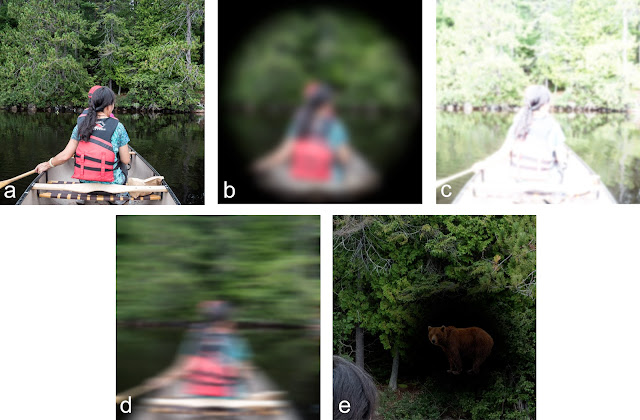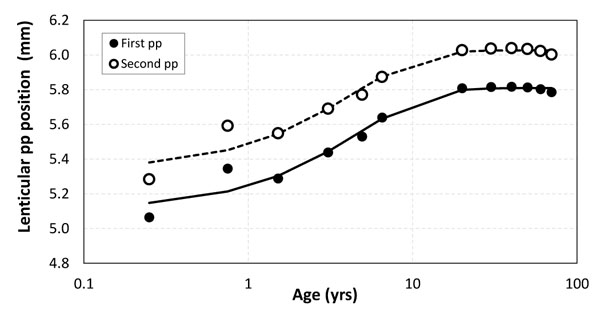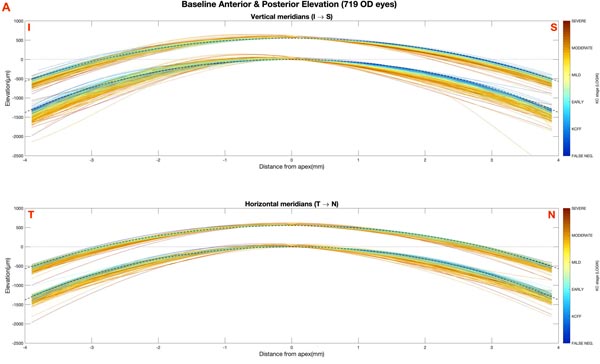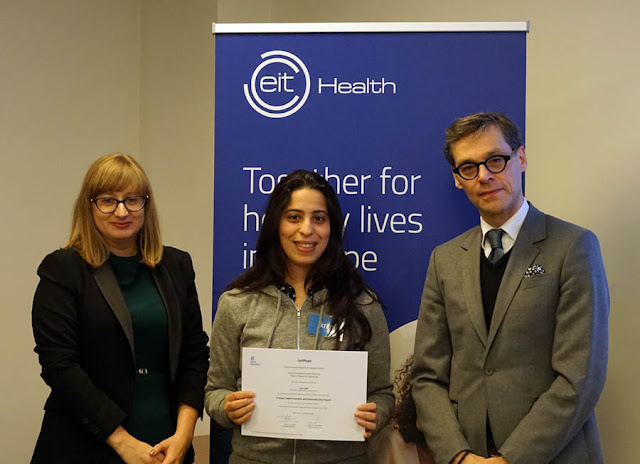Posts
Latest Posts
Arezoo and Hosna finished their PhDs
Not one, but two new PhDs in Volantis today! 🎓🎓 Congratulations toHosna GhaderiandArezoo Farzanfarwith their wonderful presentations and the great way they addressed the jury's queries. We could not be any more proud of them...- Get link
- X
- Other Apps
New paper: Generalised models of the vertebrate eye
The eyes of most vertebrates are very similar to our own in their general layout, even if their proportions can be rather different. Our latest model describes all of these eyes, and even those of cephalopods 🦑, as a set of closed form equations.Check out the paper "Generalised models of …
- Get link
- X
- Other Apps
New paper: Emmetropization and nonmyopic eye growth
Early ocular growth is a complex developmental choreography performed by the components of the eye. Most eyes start with a hypermetropic refractive error at birth, but the growth rates of the ocular components, guided by visual cues, will slow in such a way that this refractive error decreases du…- Get link
- X
- Other Apps
Hosna wins the PRESS > SPEAK competition
Hosna Ghaderi won the 2023 PRESS > SPEAK competition of the University of Antwerp, for which she had written a short text explaining her PhD research in a way that is easy to understand to non-scientists.Read her entry here: https://www.thebulletin.be/kurdish-phd-students-eye-surgery-research-w…
- Get link
- X
- Other Apps
New paper: Refractive development I: biometric changes during emmetropization
The eye undergoes many rapid changes during childhood, while maintaining a refractive error close to emmetropia during the whole process. This work uses the combined (averaged) data of 295 papers to derive regressions that describe ocular growth from before birth until adulthood. Rozema JJ. Refracti…- Get link
- X
- Other Apps
New paper: A deep look into animated eyes
We have been surrounded by animated characters all our lives. Aesthetically, the facial features of these characters tend to be simplified to allow conveying the same basic emotions easily portrayed by human actors. Eyes play a major role in these expressions, which consequently has led artists to …- Get link
- X
- Other Apps
New paper: Influence of author's gender on the peer-review process in vision science
Short before International Women's Day our latest paper was accepted, discussing how the author's gender influence may affect the peer-review timing, as well as the gender gap on senior authorships, based on over 30000 publications from the top-30 ophthalmology journals. It is evident tha…- Get link
- X
- Other Apps
New paper: Assessing the visual image quality provided by refractive corrections during keratoconus progression
This works assesses the visual image quality of keratoconic eyes corrected by means of sphero-cylindrical spectacles and rigid contact lenses as keratoconus progresses. Overall, the results reflect the clinical experience that subjective refraction is challenging in highly-aberrated keratoconic eye…- Get link
- X
- Other Apps
New paper: Modeling refractive correction strategies in keratoconus
It is challenging to find the optimal spectacle correction for a keratoconic eye. To assess this problem in detail, the SyntEys KTC model was fitted all possible spherocylindrical corrections within the range of a phoropter, each time determining the visual image quality. This demonstrated that the…- Get link
- X
- Other Apps
New paper: Reappraisal of the historical myopia epidemic in native Arctic communities
In the 1950’s Indigenous Arctic communities saw a spectacular rise in myopia prevalence, which was attributed to changes in their way of life and the introduction of formal education. Children were forced to attend ‘residential schools’ in an aggressive program of deculturalization, where they exp…- Get link
- X
- Other Apps
New paper: Forecasting progressive trends in keratoconus by means of a time delay neural network
Early and accurate detection of keratoconus progression is particularly important for the prudent, cost-effective use of corneal cross-linking and proper timing of clinical follow-up visits. This study assesses whether keratoconus progression could be predicted based on two prior tomography measure…- Get link
- X
- Other Apps
New paper: Influence of the eye globe design on biomechanical analysis
In vivo biomechanical analyses of the anterior segment often only consider a simplified layout of the eye, without much consideration for the mechanical contributions of the inner eye components on the corneal deformation.Through finite element analysis, this work demonstrates that the lens, iris, …- Get link
- X
- Other Apps
New article: Determining the Most Suitable Tomography-Based Parameters to Describe Progression in Keratoconus
Not every corneal tomography parameter is equally suited to follow-up the progression of keratoconus. This work judges the parameters provided by the Pentacam by their repeatability in different degrees of the disease, consistency between patients, and monotonicity during progression to come to an …- Get link
- X
- Other Apps
New article: Estimating principal plane positions for ocular power calculations in children and adults
As lens biometry is still difficult to obtain, authors may be inclined to make assumptions about the principal plane positions in the eye. The assumed values are usually based on the proportions of adult eye models, but these may be quite unsuitable for use in children's eyes. To this end, the …- Get link
- X
- Other Apps
Flemish Day of Science 2020
It's always a fun challenge to present your work in simple terms to an audience of children...- Get link
- X
- Other Apps
New paper: Scheimpflug Densitometry in Keratoconus: A New Method of Visualizing the Cone
Marta Jiménez García recently discovered that manifest keratoconus often goes accompanied by a bright region in the corneal densitometry that extends over the entire depth of the cornea. This may be a new way to delineate the region affected by biomechanical weakening.Jiménez-García M, Ní Dhubhghai…
- Get link
- X
- Other Apps
New paper: Age‐related axial length changes in adults: a review
Many cross-sectional studies on axial length reproted an age-related decrease that is physiologically difficult to explain. This analysis explores the possible origins of these observations and found that they are associated with gradual changes in increased body length and education level.Rozema J…
- Get link
- X
- Other Apps
New article: Repeatability of the Pentacam HR in Various Grades of Keratoconus
To understand the relative importance of tomographic indices of the Pentacam in the follow-up of keratoconus, we looked at their repeatability for varying stages of the disease, as well as for normal eyes. Maximum anterior curvature, often used in keratoconus follow-up, has a variability larger tha…- Get link
- X
- Other Apps
New article: Baseline findings in Retrospective Digital Computer Analysis of Keratoconus Evolution (REDCAKE) project
This work is the first of a series of papers to discuss the reults of the Retrospective Digital Computer Analysis of Keratoconus Evolution (REDCAKE), beginning with the baseline analysis for a large cohort of keratoconus patients. It looks at how the stage of the disease affects the cone curvature …- Get link
- X
- Other Apps
New article: Logistic index for keratoconus detection and severity scoring (Logik)
Knowing the stage of a keratoconic cornea is essential for progression follow-up and the choice of treatment. Proper staging can be challenging, however, since many of the available parameters are inadequate to the task (e.g. K_max and Pachy_min). This inspired us to develop the Logistic Index for…- Get link
- X
- Other Apps
Ikram graduated from H Impact
Ikram successfully graduated from the H Impact program at the Ghent University, which promotes innovation and entrepreneurship in health care. She was part of the EyeOnCancer team, who pitched their ideas about a platform to provide customized advice for cancer patients.- Get link
- X
- Other Apps
See how your straylight affects your driving ability
Volantis is looking for volunteers to participate in a study on the relationship between straylight and driving ability in a real driving simulator. Do you have your drivers license and are you willing to go to Hasselt for the testing? Then please contact us for more information.- Get link
- X
- Other Apps
New article: Differences in ocular biometry between urban and rural children matched by refractive error: the Shandong Children Eye Study
Using the data from the Shandong Children Eye Study, we established that children living in the countryside and those living in cities have fundamentally different eye structure, despite having the exact same refraction. Mediation analysis demonstrated that this difference is associated with the w…- Get link
- X
- Other Apps



















